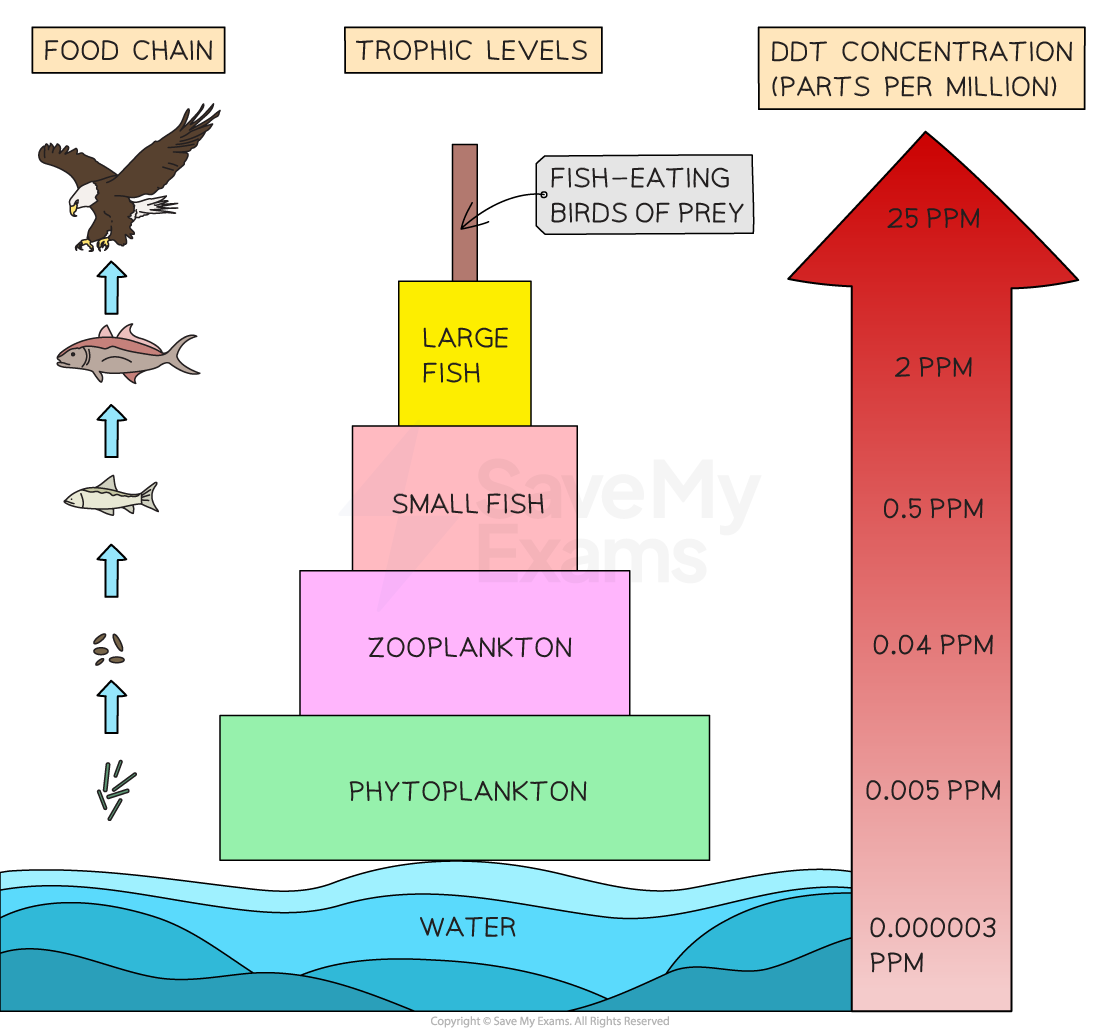The Effects of Pollution (DP IB Biology): Revision Note
Biomagnification of Pollutants
Biomagnification is the increase in concentration of persistent or non-biodegradable pollutants with ascending trophic level through a food chain
Not to be confused with bioaccumulation, which is the build-up of pollutants within an organism, or within a single trophic level
As pollutants are passed up the food chain from one trophic level to the next, they can become more concentrated due to the decrease in total biomass of organisms at higher trophic levels
I.e. the smaller organisms at the bottom of the food chain will each consume a small volume of pollutant, and then the organisms at the top of the food chain will consume many smaller organisms and receive a much larger dose of pollutant
Biomagnification of DDT
Toxins such as DDT (dichlorodiphenyltrichloroethane) are persistent pollutants that can enter food chains
DDT was a widely used insecticide in the mid-20th century that was found to have harmful effects on top predators such as birds of prey
When DDT was sprayed on crops, it would leach into waterways and eventually enter freshwater and marine ecosystems
DDT would then enter food chains via plankton and accumulate in the bodies of fish
These fish would then be eaten by birds, which would accumulate higher concentrations of DDT
Because DDT is persistent and does not break down easily, it can continue to accumulate in the bodies of animals at higher trophic levels, leading to harmful effects such as thinning of eggshells and reduced reproductive success
The thin eggshells could not withstand the weight of the parent bird during incubation, so the eggs would break and fewer young birds would hatch
Over time this resulted in reduced bird populations
DDT has now been banned worldwide, with the exception of its use in areas where it is essential in dealing with mosquitos that transmit malaria
Biomagnification of DDT diagram

Through the process of biomagnification, the concentration of DDT in the tissues of organisms increases at successively higher trophic levels in a food chain
Biomagnification of mercury
Mercury is another example of a pollutant that can accumulate through food chains
Mercury is released into the environment through activities such as coal-fired power plants and gold mining
Once in the environment, mercury can be converted by microorganisms into a highly toxic form called methyl mercury, which can accumulate in the bodies of fish
As larger fish eat smaller fish, the concentration of methyl mercury within the tissues of these fish increases, leading to potential harm for humans who eat large predatory fish such as tuna or swordfish
Effects of Plastic Pollution
Plastics have a large negative impact on both land and water habitats due to their non-biodegradable nature
Plastics that can cause pollution problems include
Macroplastics; these are plastic items that are more than 5 mm in length, and include plastic bags, bottles, food packaging, and fishing nets
Microplastics; pieces of plastic that are less than 5 mm in length
Microplastics come from macroplastics that have been broken into smaller pieces by, e.g. wave action or UV rays
In marine habitats:
Animals often try to eat plastic, e.g.
Turtles may attempt to eat a plastic bag that resembles a jellyfish
Albatrosses may accidentally consume plastic when they fish, giving it to their chicks when they regurgitate food; the chicks may later starve due to their stomachs being full of plastic
Animals become caught in plastic, such as fishing lines, leading to injuries and death
As the plastic breaks down it can release toxins that can lead to biomagnification in the food chain
Once it has broken down into very small particles, it is commonly ingested by animals and enters the food chain
NOS: Scientists can influence the actions of citizens if they provide clear information about their research findings
The impacts of plastic pollution have become very well understood by the public in recent years due to effective communication of the findings of scientists
E.g. Popular wildlife documentaries have shown footage of sea birds feeding plastic to their chicks
This type of clear science communication can change public behaviour
People have petitioned food companies and supermarkets to reduce their plastic packaging
People may shop at stores that use less plastic
People may get better at household recycling and taking their rubbish home
People may opt for non-plastic items in their home, such as bamboo toothbrushes or paper straws for drinking

Unlock more, it's free!
Did this page help you?